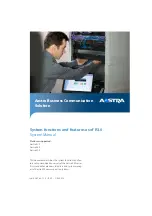
116
SuperServer 7088B-TR4FT User's Manual
Appendix D
UEFI BIOS Recovery Instructions
Warning:
Do not upgrade the BIOS unless your system has a BIOS-related issue. Flashing
the wrong BIOS can cause irreparable damage to the system. In no event shall Supermicro
be liable for direct, indirect, special, incidental, or consequential damages arising from a BIOS
update. If you need to update the BIOS, do not shut down or reset the system while the BIOS
is updating to avoid possible boot failure.
D.1 Overview to UEFI BIOS
The Unified Extensible Firmware Interface (UEFI) specification provides a software-based
interface between the operating system and the platform firmware in the pre-boot environment.
The UEFI specification supports an architecture-independent mechanism for add-on card
initialization to allow the UEFI OS loader, which is stored in the add-on card, to boot up the
system. UEFI offers a clean, hands-off control to a computer system at bootup.
D.2 Recovering the UEFI BIOS Image (Main BIOS Block)
A UEFI BIOS flash chip consists of a recovery BIOS block, which is comprised of two boot
blocks and a main BIOS block (the main BIOS image). The boot block contains critical BIOS
codes including memory detection and recovery codes for the user to flash a new BIOS
image if the original main BIOS image is corrupted. When the system power is on, the boot
block codes execute first. Then the main BIOS code will continue with system initialization
and bootup.
Note:
Follow the BIOS recovery instructions below when the main BIOS boot crashes.
D.3 Recovering the UEFI BIOS with a USB Device
This feature allows the user to recover a BIOS image using a USB device without the need
of additional utilities. A device such as a USB flash drive or a USB CD/DVD ROM/RW can
be used. A USB hard disk drive cannot be used for BIOS recovery at this time.
To perform UEFI BIOS recovery using an attached device, follow the instructions below.
1.
Using a different system, copy the "Super.ROM" binary image file into the disc Root "\"
directory of a USB device or a writeable CD/DVD.
Note:
If you cannot locate the "Super.ROM" file in your driver disk, visit our website at www.
supermicro.com to download the BIOS image to a USB flash device and rename it "Super
ROM".




































